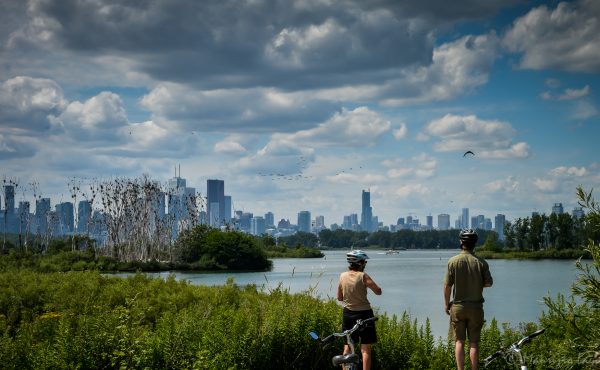
When Infrastructure Ontario executes public-private partnership arrangements, there are numerous permutations — design-build-finance-maintain, outright land sales, straight-up contracting gigs (e.g., to rebuild a fire station). The deals run the gamut, from technology infrastructure upgrades to major transit projects and development opportunities for real estate in the vicinity of a transit station. And when the winning bidder(s) are made public, the winners mostly, though not always, include a financial partner.
For Ontario Place, however, IO awarded the contract with few details about the winning bidders, besides their names — Therme Group and Live Nation — and the various planning and design consultants hired to provide work out the details. Given the sheer size of the project — Therme has said it will spend $350 million on the spa, plus another $100 million on the public space around it, while IO has estimated the price-tag for site preparation will be $200 million — the fact that Queen’s Park hasn’t (yet) disclosed a financial partner is a conspicuous omission.
As Spacing has reported previously, Therme, headquartered in Vienna, is owned by a privately held Munich-based HVAC and refrigeration equipment manufacturer called A-Heat Allied Heat Exchange.
But the company actually sits at the heart of a complicated network of subsidiaries, funding relationships with non-profits, and links to private equity outfits — a far more extensive corporate organization than the one founded in 1998.
Therme’s first three European spas, in Germany, were partnerships with Wund Holding GmbH, established by the firm’s founder Josef Wund. A fourth opened in Romania in 2016.
Wund’s death in 2017 triggered a major restructuring, as well as the launch of an ambitious global expansion. According to the World Economic Forum website, Therme now describes itself as “a leading global wellness company and an integrator of wellness and entertainment concepts focused on revolutionizing the health and well-being industry.”
At the moment, the company is building spas in Frankfurt, Manchester and Glasgow, the latter two in partnership with a large U.K. property developer, Peel L&P.
Yet Therme Group claims it will also be developing five comparably scaled spas in the U.S., including New York, Chicago and Los Angeles, as well as a sixth in South Korea. The firm last week announced it had established a year-long partnership with municipal officials in Washington D.C. to find a location and “collaborate on efforts to engage with council members, business leaders, community partners, and residents.”
The company’s global expansion drive could cost well over $2 billion, on top of the investment planned for the West Island. Therme is also making significant capital investments in its existing spas, just a few years after it told German officials that it risked bankruptcy due to the pandemic.
There’s no information to date about the source of all this financing. According to Therme Canada spokesperson Simon Bredin, “Therme Canada and Therme Group, backed by parent A-Heat AG, are in a strong financial position and able to support the project through development to completion.”
Spacing, however, has learned further details about the company’s corporate ties and backers, based on online information as well as disclosure documents scraped from European Union “beneficial ownership” disclosure registries and made public by an investigative journalism database called the Organized Crime and Corruption Reporting Project.
(Many countries have established beneficial ownership registries in an effort to halt the use of shell companies in tax havens for money laundering. The federal government introduced new beneficial ownership legislation this past March but the reforms have yet to take effect. Luxembourg, whose banking secrecy rules have come under scrutiny by OpenLux, an international investigative journalism network, introduced its own more limited disclosure requirements in 2019.)
DETAILS OF OUR FINDINGS
The firm that claims to support Therme’s “well-being infrastructure” is Impact One GmbH, a company that describes itself as an ‘impact investor” and is domiciled in Luxembourg. Its address is an office building occupied by Arendt, a prominent business and legal advisory services firm whose clients include holding companies registered in the tiny European country, long known as a highly secretive tax haven. “Impact investing” is part of the ESG trend, and describes an approach that sees capital invested in related for-profit and non-profit activities.
“Therme Canada has no financial relationship with Impact One,” says Bredin. “Globally, Therme Group and Impact One share a common vision of support for Indigenous communities, afforestation, and the study of urban wellness outcomes, and internationally Therme Group has financially supported Impact One’s sustainability and arts initiatives.”
Besides its support for Therme’s spas, Impact One says it also funds reforestation initiatives, mental health initiatives, a Miami experiential art emporium called SuperBlue, and “research projects that aim to deepen our understanding of the complex processes and factors that affect human and planetary health.”
Impact One’s founder is also the head of Therme’s art division, Mikolaj Sekutowicz, a lawyer who joined Wund in 2009 and also currently serves as Therme Group’s vice-president. Impact One’s board is chaired by a prominent European wealth manager named Roksana Ciurysek-Gedir. Once the deputy CEO of Poland’s largest financial institution, Bank Pekao, she has also worked in London, including stints at Credit Suisse, Edmond de Rothschild and Merrill Lynch. Ciurysek-Gedir currently chairs a “global impact” advisory board of a large San Francisco-based alternative asset fund, White Oaks Global Advisors LLC, which has private equity holdings in excess of US$6.8 billion and whose executive team includes Warren Buffett’s son, Howard. According to Bloomberg, its assets include a US$195 million impact investing fund.
Besides her professional CV, Ciurysek-Gedir describes herself as an artist and filmmaker, and has sold her diamond encrusted photographs at auction. She currently serves as Faberge’s “artist in residence,” according to her World Economic Forum bio.
The company’s culture division, Therme Art, has close ties to both its financial backers and high-end players in the European and U.K. art worlds, among them the Swiss auction house de Pury, the head of Art Basel (a trend-setting art festival), prominent curators, artists and architects, and patrons, including a Libyan princess who is well connected in British, Swiss and Saudi Arabian art circles. Some of Impact One’s support goes towards organizations represented on Therme’s art advisory board, while Therme itself has divisions that sponsor wellness projects, sustainable travel, horticulture, architecture and “cross sectoral events.”
Another recipient of Therme’s philanthropic support is something called the Institute for Climate Protection, Energy and Mobility,which is a partnership between a German university and yet another Therme division called Therme One Health.
U.K. registration documents gathered by OCCRP show that Therme’s U.K. operations include numerous limited liability subsidiaries — Therme Group Projects UK, Therme Group Holdings, Therme Group Services, etc. — that all list as their address a north-end London-based investment management outfit called Blu Family Office. (“Family offices” are established by and for wealthy families, often multi-generational with large sums of capital to invest; they function like independent management advisors and asset managers.) These disclosures do not indicate the source of the capital that Blu is investing.
Therme also has a holding company registered in Cyprus as well as a U.S. division based in an office in Soho, New York. Therme’s American operation, which is still looking for a New York location, is fronted by the founder of the High Line, Robert Hammond, who last week appeared at a “wellness, real estate and communities symposium” held at the JPMorgan Chase headquarters in NYC just a few days before the company announced its Washington D.C. plans.
What’s apparent from the company’s nested corporate and philanthropic relationships is that it is exceptionally well connected to the worlds of art, philanthropy, finance and real estate.
Bredin says that at Ontario Place, Therme “is obligated to deliver a destination entertainment and wellbeing attraction…Other uses are not permitted.”
What’s less clear is the origin of Therme’s capital, and, in particular, the funding required to build an almost half-billion-dollar facility on the West Island at Ontario Place. Given that the Ford government is executing a 95-year lease through a process overseen by Infrastructure Ontario, it would seem prudent for provincial officials to know precisely who it is dealing with, and the ultimate source and terms of the firm’s financing.
photo courtesy of Therme





7 comments
I believe that Ford and company already know who and what they’re dealing with here, and that knowledge is driving them to keep the details as opaque as possible. Further investigation and disclosure is therefore needed.
The article’s title: “EXCLUSIVE: WHAT IS THE SOURCE OF THERME’S FINANCING?”
The article: “What’s less clear is the origin of Therme’s capital, and, in particular, the funding required to build an almost half-billion-dollar facility on the West Island at Ontario Place.”
So.. basically the answer is that we still have no idea? Clickbait of the highest order.
Jason: Are you serious? This is the most we’ve ever heard about their finances, no thanks to Therme. The nothing burger is between your ears.
Ontario Place is public land held in perpetuity for the public at large. Politicians are expected to hold that land in trust on behalf of the public for their term in office. How can any administration give away these assets on such long leases? Public recreation land is already in short supply in a congested metropolitan area. Just doesn’t smell right.
Why can’t the author come right out and say it, this company is part of an international money laundering scheme of the highest level. Further to that the press in Toronto generally seem either to be really out to lunch in a way that the press of even the 1970’s were not. I guess you have to have a degree in journalism, or urban planning, to not know that the condo boom itself, our biggest planning elephant in the neighbourhood, is money laundering. This all goes back generations, the concrete industry – mafia, the re-bar and construction steel industry-mafia, the crane companies (if there is even more than one company..)-mafia. Are you guys afraid to say it? This is a much wider topic, but the same as Ontario Place of course. The “density” trope is the best scam the mafia ever pulled on the leftists and progressives!! Sadly the city is being destroyed, history and communities torn apart, small businesses and artists driven out, cultural landmarks destroyed, to provide a financial vehicle for outside investors and a laundering mechanism for international organized crime. And I am afraid Spacing has been part of spreading this goofy, blunt instrument criticism of the old city. Density is only simplest descriptor of the complexity, economic and social, that exists in the old centers of our cities. It seems to escape our learned chroniclers at Spacing and elsewhere that in the quest for density property ownership and management become deeply concentrated and huge, next level amounts of money are siphoned out of the city, out of the province and out of the country to feed investors. And of course the Ford family’s ties to organized crime are not hard to dig up, going back into the father’s era as a pro paving, pro development, anti public control cabinet minister. Please Spacing, don’t be afraid to call a spade a spade!
Thanks to Robin Easton for saying that.
I doubt the majority stakeholders and officers of all the shell companies of this Austrian-based business that seems to have sprung up in the last five years, were checked by the Ford government if they are on any of the new sanction lists the federal government put in place after the war in Ukraine broke out. Given that there has been no shortage of dirty Russian money political and business scandals in Austria in the last 10 years, would we be surprised if Therme stakeholders or their proxies are on the sanction lists? I doubt it. It also convenient for Ford and company that the lease was signed before 2023, however sanction lists existed before then and the public should know who is running this company and where it’s funding it’s coming from. It’s a little hard to believe that aan HVAC manufacturer has the ability to frivolously spend a half a billion here, a half a billion there to build spa to a scale it hasn’t operated before. The press needs to do a better job of digging around, because we are sure Ford and company would like to keep everything a secret.